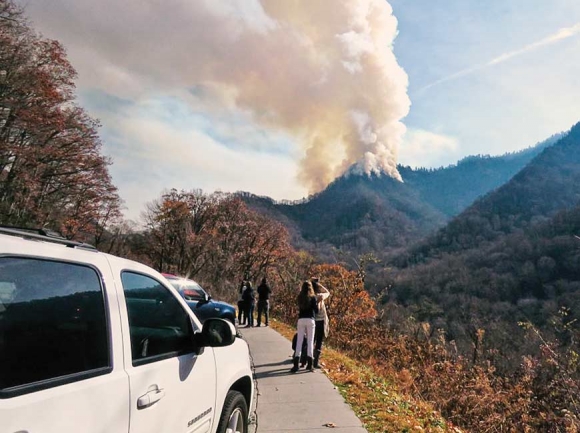2016: Fire on the mountain
 Smoke billows from the Chimney Tops during the early days of the fire that would eventually sweep a path of destruction through Gatlinburg and Pigeon Forge. NPS photo
Smoke billows from the Chimney Tops during the early days of the fire that would eventually sweep a path of destruction through Gatlinburg and Pigeon Forge. NPS photo
As you read this, I’ve just noted the passing of my third anniversary with this 20 year-old newspaper and as such, the retrospectives I was charged to write this week were all on events that took place long before my arrival — except for this one.
I’d only been here for about five months when the first musky whiffs of smoke began to appear over the horizon, but being as my experience and training disposes me to cover politics and government, I continued to busy myself with the upcoming General Election. Besides, we happen to have on our staff one of the most accomplished and knowledgeable outdoors writers in the game, the multi-multi-multi-award-winning Holly Kays.
As we all worked late into the evening on Election Night, Tuesday, Nov. 8, 2016, it started to look and smell as though something was gravely amiss.
No, it wasn’t the unexpected victory of Donald Trump — it was the heavy smoke in downtown Waynesville, which over the previous days had really started to become unbearable.
I had been watching it ebb and flow for a week, and thanks to the constant exposure had also nursed a low-grade headache for days.
Kays’ Nov. 9 stories chronicled a region already wracked by a historic drought that by that time had fostered forest fires totaling more than 11,000 acres — about 17.5 square miles — in and around the Nantahala National Forest.
Related Items
“And counting,” she wrote.

And she was — each morning I’d show up to the office to find her on the phone.
“How many acres now?” she’d ask them, checking in on the acreage of more than a dozen active fires while searing into my memory the names of these far-off places — Dicks Creek, Whitewater Falls, Moss Knob, Jones Gap.
One week after the election, it seemed as though our whole world was on fire.
The conflagrations were now visible from space and had grown to more than 33,000 acres at 20 distinct sites across Western North Carolina alone. From almost every state in the union, firefighters — at least 1,200 of them — were here, working furiously to save people and property from certain incineration. Perhaps most infuriating was that the majority of the fires were suspected arsons.
“It’s wicked, evil, that they would destroy the forest,” Franklin resident Victor Mora Loza told Kays on Nov. 16. “I’d like to kick their ass.”
That week, the explosive growth of the fires pressed all of us into service, including me. I wrote a story on the dangers of breathing the smoke — ironic, for a habitual cigarette smoker — and learned that from Nov. 5 through Nov. 16, the N.C. Department of Environment and Natural Resources’ Air Quality Division reported two of those days as “moderate,” six days as “unhealthy for sensitive groups” and four days as just plain “unhealthy.” Not once since Nov. 4 was air quality considered “good.”
Even our IBMA-nominated Rolling Stone-contributing Arts and Entertainment Editor Garret K. Woodward — who writes news stories about as often as I write music stories, which is to say, never — got in on the action by surveying tourists and businesses throughout the far western portions of our coverage area.
“We’ve absolutely taken a financial hit,” Nantahala Brewing co-owner Joe Rowland told Woodward in Bryson City. “This past week we did roughly half the business we did at this same time last year. A lot of businesses in this town — this region — depend on tourism. Folks are either not able to get up here or won’t come here due to health concerns from the smoke. This lack of tourism is going to cost this area a lot.”

The Ferebee Fire came within feet of the Nantahala Outdoors Center before finally being contained. Garret K. Woodward photo
SMN News Editor Jessi Stone, usually charged with the unenviable task of herding me, Kays and Woodward to print each week, also dropped some words on the topic, reporting on still-dry conditions that threatened operations at Canton’s paper mill and led to water restrictions in Canton, Clyde, Franklin, Maggie Valley and within the Jackson County service area of the Tuckaseigee Water and Sewer Authority.
The next week Kays was back at it, making her calls and reporting the best news we’d heard since early November — the amount of acreage ablaze had “only” grown by 4 percent in the preceding week, and many fires seemed to be contained.
But that was before 90-mile-per-hour winds snapped trees, cut power lines and whipped a mostly-contained fire at Chimney Tops over the mountains to Pigeon Forge and Gatlinburg, Tennessee, on Nov. 28.
That fire was made famous by Gatlinburg residents Michael Luciano and Anthony Fulton who, while attempting to drive out of it, filmed a harrowing video of their escape down a fiery mountain.
“That ended up being where hell started,” Luciano told Kays. “It did not end until we got to the very bottom.”
They’re lucky they did; more than 2,400 buildings were destroyed and 14 people died, but once the smoke cleared, there were some positive takeaways.
Scientists quickly converged on what Kays called “a fire-forged laboratory” and continue to monitor how, exactly, flora and fauna are rebounding from the devastation.
A 2017 report on the Great Smoky Mountains National Park’s response to the fires found no negligence on the part of employees, but did point out some shortcomings in the way of communication, staffing and training.
And this past February, Haywood County — largely spared from the flames — played host to a four-day drill that drew 100 emergency management professionals from across the state to deal with a simulated wildfire, in hopes that they’ll never see what we all lived through that fall.









